|
News Archive: Nov. 1-30 |

|
Huygens probe's Titan landing site determined
Scientists have discovered exactly where on Saturn's largest moon, Titan, the European Space Agency's Huygens probe landed last January. Knowing the landing location will allow them to directly compare data from Huygens with remote sensing data from NASA's Cassini orbiter.
 FULL STORY FULL STORY
 |  |
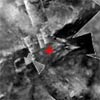
|
 |

Additional coverage for subscribers:
 VIDEO:
SCIENTISTS HOLD HUYGENS RESULTS NEWS BRIEFING PLAY VIDEO:
SCIENTISTS HOLD HUYGENS RESULTS NEWS BRIEFING PLAY
 SUBSCRIBE NOW SUBSCRIBE NOW

|
Titan's methane likely comes from inside
The methane giving an orange hue to Saturn's giant moon Titan likely comes from geologic processes in its interior according to measurements from the Gas Chromatograph Mass Spectrometer aboard the European Space Agency's Huygens probe. The instrument also found evidence of liquid methane in the surface material.
 FULL STORY FULL STORY
 |  |

|
 |
Titan gives clues to Earth's early history
Readings from the Huygens probe of the surface and atmosphere around Saturn's largest moon, Titan, give researchers a peek back through time to when and how Earth's atmosphere formed, and how our
primitive planet looked before life took a foothold here.
 FULL STORY FULL STORY
 |  |
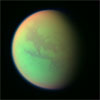
|
 |
Mars Express finds buried craters, underground ice
For the first time in the history of planetary exploration, the MARSIS radar on board the European Space Agency's Mars Express has provided direct information about the deep subsurface of Mars.
 FULL STORY FULL STORY
 |  |
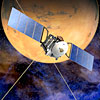
|
 |

Additional coverage for subscribers:
 VIDEO:
MARS EXPRESS FINDINGS ANNOUNCED AT NEWS BRIEFING PLAY VIDEO:
MARS EXPRESS FINDINGS ANNOUNCED AT NEWS BRIEFING PLAY
 SUBSCRIBE NOW SUBSCRIBE NOW

|
Rover helps reveal possible secrets of Martian life
Life may have had a tough time getting started in the ancient environment that left its mark in the Martian rock layers examined by NASA's Opportunity rover. The most thorough analysis yet of the rover's discoveries reveals the challenges life may have faced in the harsh Martian environment.
 FULL STORY FULL STORY
 |  |
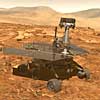
|
 |
Thruster problem latest hurdle for asteroid probe
After weeks of confusion and setbacks, the Japanese Hayabusa probe finally met with success last week in its mission to retrieve the world's first assortment of asteroid specimens that will be bound for Earth within the next few weeks -- if controllers can put an end to a potentially ruinous problem with thrusters needed for the trip home.
 FULL STORY FULL STORY
 |  |
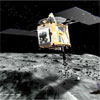
|
 |
Possible birth of tiniest known solar system found
Scientists using a combination of ground-based and orbiting telescopes have discovered a failed star, less than one-hundredth the mass of the Sun, possibly in the process of forming a solar system. It is the smallest known star-like object to harbor what appears to be a planet-forming disk of rocky and gaseous debris, which one day could evolve into tiny planets and create a solar system in miniature.
 FULL STORY FULL STORY
 |  |

|
 |
OTHER HEADLINES Additional stories today
|
 |
New NASA Advisory Council holds inaugural meeting -- Two former Apollo astronauts joined 22 other experts in the first meeting of the newly restructured NASA Advisory Council, a group of eminent U.S. citizens organized to provide guidance and policy advice to the administrator of America's space agency.

Review of record-setting 2005 Atlantic hurricane season -- The 2005 Atlantic hurricane season is the busiest on record and extends the active hurricane cycle that began in 1995 - a trend likely to continue for years to come. The season included 26 named storms, including 13 hurricanes in which seven were major (Category 3 or higher).
|
 |
Cassini discovers 'fountains' on Saturn moon
The Cassini spacecraft has revealed a fine spray of small, icy particles emanating from the warm, geologically unique province surrounding the south pole of Saturn's moon Enceladus.
 FULL STORY FULL STORY
 |  |

|
 |
Fractured terrain of Dione
Dione's icy surface is scarred by craters and sliced up by multiple generations of geologically-young bright fractures. Numerous fine, roughly-parallel linear grooves run across the terrain in the upper left corner in this newly-released Cassini image.
 FULL STORY FULL STORY
 |  |

|
 |
OTHER HEADLINES Additional stories today
|
 |
Orbital to build, launch NASA's ST8 satellite -- Orbital Sciences will design, develop and manufacture the next satellite in NASA's series of New Millennium Program technology demonstration spacecraft.
|
 |
Venus-bound spacecraft looks back at Earth
The European Space Agency's Venus Express space probe recently pointed its imaging spectrometer at Earth, snapping this image of the home planet. The observation was made from 2.2 million miles away.
 FULL STORY FULL STORY
 |  |

|
 |
Scrub called in Falcon rocket's first launch try
A frustrating scrub Saturday ended the first shot at launching the privately-developed Falcon 1 rocket, delaying until sometime in December the debut mission of this new low-cost booster fleet that could revolutionize the space marketplace.
 FULL STORY FULL STORY
 MISSION STATUS CENTER MISSION STATUS CENTER
 PHOTOS: PRE-LAUNCH GALLERY PHOTOS: PRE-LAUNCH GALLERY
 MISSION PREVIEW STORY MISSION PREVIEW STORY
 LAUNCH TIMELINE STORY LAUNCH TIMELINE STORY
 |  |
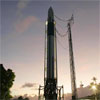
|
 |
Herschel sees the Sun
Impact-battered Mimas steps in front of Saturn's rings, showing off its giant 80-mile wide crater Herschel to the Cassini spacecraft. The illuminated terrain seen here is on the moon's leading hemisphere.
 FULL STORY FULL STORY
 |  |

|
 |
Sharp vision reveals intimacy of stars
Two international teams of astronomers have observed with unprecedented detail the environment of two stars. One is a young, still-forming star and the new results provide useful information on the conditions leading to the creation of planets. The other is on the contrary a star entering the latest stages of its life. The astronomers found, in both cases, evidence for a surrounding disc.
 FULL STORY FULL STORY
 |  |

|
 |
On approach to Dione
Cassini captured Saturn's moon Dione -- a brilliant, cratered iceball -- in front of its shadow-draped planet in this picture taken during a recent rendezvous by the NASA spacecraft. The terrain seen here becomes notably darker toward the west, and is crosscut by the bright, fresh canyons that form wispy markings on Dione's trailing hemisphere.
 FULL STORY FULL STORY
 |  |
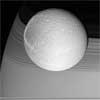
|
 |
Probe makes another asteroid sampling attempt
Japan's Hayabusa spacecraft appeared to land on an asteroid Friday for a brief shot at gathering samples for return to Earth. The problem-plagued mission had encountered numerous problems, and officials said dwindling fuel reserves meant Friday's sampling attempt would be the last one possible. Mission officials are analyzing data to determine whether the final try has been successful.
 PREVIEW STORY PREVIEW STORY
 |  |
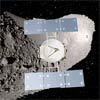
|
 |
'Alien' life included in biology classification
What would you call an alien if you encountered it on the street tomorrow? What if that alien didn't come from another world but rather was created in a laboratory right here on Earth and functioned differently from other Earth life?
 FULL STORY FULL STORY
 |  |
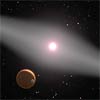
|
 |
Cause of Discovery tank foam loss still unresolved
Four months after the shuttle Discovery's long-awaited return to flight last July, NASA engineers still don't know what caused a large piece of potentially dangerous foam to break away from a so-called PAL ramp on the side of the ship's external fuel tank.
 FULL STORY FULL STORY
 |  |
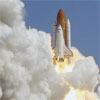
|
 |

Additional coverage for subscribers:
 VIDEO:
TUESDAY'S SHUTTLE PROGRAM UPDATE DIAL-UP | BROADBAND VIDEO:
TUESDAY'S SHUTTLE PROGRAM UPDATE DIAL-UP | BROADBAND
 VIDEO:
QUESTION & ANSWER SESSION DIAL-UP | BROADBAND VIDEO:
QUESTION & ANSWER SESSION DIAL-UP | BROADBAND
 MORE: STS-114 PRE-FLIGHT COVERAGE HERE MORE: STS-114 PRE-FLIGHT COVERAGE HERE
 MORE: STS-114 LAUNCH TO LANDING HERE MORE: STS-114 LAUNCH TO LANDING HERE
 SUBSCRIBE NOW SUBSCRIBE NOW

|
Mars rover comes alive with Hollywood special effects
Must-see synthetic images of the Mars Exploration Rover Spirit in the "Columbia Hills" have been produced using "Virtual Presence in Space" technology. Developed at NASA's Jet Propulsion Laboratory, this technology combines visualization and image-processing tools with Hollywood-style special effects to give viewers with a sense they were there with the rover.
 FULL STORY FULL STORY
 |  |
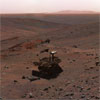
|
 |
SpaceDev: Lunar missions for less than $10 billion
SpaceDev says the results of its lunar exploration study indicate that a more comprehensive series of missions could be completed in a fraction of the time for one-tenth of the cost vs. NASA's recently announced plans.
 FULL STORY FULL STORY
 |  |

|
 |
Sleek rings, rugged moon
Rhea floats below the innermost regions of Saturn's amazing rings in this Cassini spacecraft image. This view of the Saturn-facing hemisphere of Rhea allows a glimpse of the wispy terrain that covers the trailing hemisphere of Rhea.
 FULL STORY FULL STORY
 |  |

|
 |
Asteroid probe fails to land for sampling mission
A crucial milestone in the Hayabusa asteroid mission failed this weekend after officials confirmed the craft did not succeed in its planned momentary asteroid touchdown.
 FULL STORY FULL STORY
 |  |

|
 |
Mars Express radar data analysis is on the move
The Mars Express radar, MARSIS, has now been deployed for more than four months. The craft has been making its closest approaches to Mars predominantly in the daytime portion of its orbit, and the radar's scientists are mainly collecting data about the upper layers of the Martian atmosphere.
 FULL STORY FULL STORY
 |  |
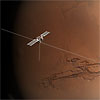
|
 |
OTHER HEADLINES Additional stories today
|
 |
NASA honors veteran astronaut Walter Schirra -- NASA honored veteran astronaut Walter M. Schirra, Jr., as an Ambassador of Exploration November 16 during a ceremony at the San Diego Aerospace Museum. NASA is presenting these prestigious awards to the astronauts who took part in the nation's Mercury, Gemini and Apollo space programs from
1961 to 1972. Schirra is the only man to fly in all three space programs.

NASA honors Apollo astronaut Richard Gordon -- NASA honored veteran astronaut Richard Gordon, Jr., November 17 as an Ambassador of Exploration during a ceremony at The Museum of Flight in Seattle. Ambassadors of Exploration help NASA communicate the benefits and excitement of space exploration.

First Hispanics join NASA's Mission Control team -- The first person of Hispanic heritage to lead Mission Control is working shifts as a flight director for the International Space Station at NASA's Johnson Space Center, Houston. Ginger Kerrick completed more than 700 hours of training and began active duty in September.
|
 |
New class of 'supergiant' X-ray binary stars found
ESA's Integral gamma-ray observatory has discovered a new, highly populated class of X-ray fast 'transient' binary stars, undetected in previous observations. 'Transients' are systems which display periods of enhanced X-ray emission.
 FULL STORY FULL STORY
 |  |

|
 |
Mars-bound craft tweaks course, passes halfway
NASA's Mars Reconnaissance Orbiter successfully fired six engines for about 20 seconds Friday to adjust its flight path in advance of its March 10, 2006, arrival at the red planet. Since its Aug. 12 launch, the multipurpose spacecraft has covered about 60 percent of the distance for its trip from Earth to Mars.
 FULL STORY FULL STORY
 |  |

|
 |
Einstein's rings in space
A ring often serves as the visible symbol of the unseen - be it mystical, Lord of the Rings-style power or the devotion between two people. In space, a ring of light is more than a symbol. It is a guidepost to unseen matter and a beacon from galaxies in the distant universe.
 FULL STORY FULL STORY
 |  |
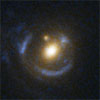
|
 |
SpaceX reveals schedule for debut Falcon 1 launch
Commercial start-up company Space Exploration Technologies, or SpaceX, is hosting a press conference this afternoon to announce plans for its inaugural launch of the small Falcon 1 rocket from the Marshall Islands. The vehicle will launch a student-built military satellite at 4 p.m. EST (2100 GMT) next Friday. The day's launch window runs four hours.
 EARLIER PREVIEW STORY EARLIER PREVIEW STORY
 LAUNCH PAD ENGINE TEST-FIRING LAUNCH PAD ENGINE TEST-FIRING
 SPACEX HAS GRAND PLANS SPACEX HAS GRAND PLANS
 |  |
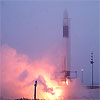
|
 |
Graceful lanes of ice
The dark Cassini Division, within Saturn's rings, contains a great deal of structure, as seen in this color image from the robotic space mission of the same name. Spectroscopic observations indicate that the Cassini Division, similar to the C ring, contains more contaminated ice than do the B and A rings on either side.
 FULL STORY FULL STORY
 |  |

|
 |
Kibosh put on alternative theory of star formation
Astrophysicists have exploded one of two competing theories about how stars form inside immense clouds of interstellar gas.
 FULL STORY FULL STORY
 |  |
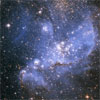
|
 |
Pandora's color close-up
Cassini's best close-up view of Saturn's F ring shepherd moon, Pandora, shows that this small ring-moon is coated in fine dust-sized icy material. Craters formed on this object by impacts appear to be covered by debris, a process that probably happens rapidly in a geologic sense.
 FULL STORY FULL STORY
 |  |
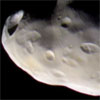
|
 |
Ariane 5 roars to space
An Arianespace Ariane 5 ECA rocket launched from the Guiana Space Center in South America on Wednesday evening, hauling into orbit the Spaceway F2 broadcasting satellite for DIRECTV and the Indonesian Telkom 2 communications spacecraft.
 MISSION STATUS CENTER MISSION STATUS CENTER
 |  |

|
 |
Hill-climbing Mars rover catches moon eclipse
NASA's Mars Exploration Rover Spirit continues to take advantage of favorable solar power conditions to conduct occasional nighttime astronomical observations from the summit region of "Husband Hill." Spirit has been observing the martian moons Phobos and Deimos to learn more about their orbits and surface properties. This has included observing eclipses.
 FULL STORY FULL STORY
 |  |

|
 |
Spitzer harvests dozens of new stars
Just in time for Thanksgiving, NASA's Spitzer Space Telescope has harvested a bounty of young stars. A new infrared image of the reflection nebula NGC 1333, located about 1,000 light-years from Earth in the constellation Perseus, reveals dozens of stars like the Sun but much younger.
 FULL STORY FULL STORY
 |  |

|
 |
OTHER HEADLINES Additional stories today
|
 |
Second Milstar achieves 10 years in service -- The second U.S. Air Force Milstar communications satellite, built by a team led by Lockheed Martin, has surpassed its 10-year design life of on-orbit service and will continue to provide secure, reliable and robust communications to U.S. and Allied Forces around the globe well into the future.

Sea Launch signs with DIRECTV for launch in 2007 -- Sea Launch has signed a firm launch contract with DIRECTV, for a mission scheduled in early 2007. The new contract calls for a Zenit-3SL vehicle to launch a DIRECTV spacecraft to geosynchronous transfer orbit from Sea Launch's Odyssey Launch Platform, positioned on the Equator.
|
 |
Coming soon: Sun in 3-D
The first spacecraft designed to capture 3-D "stereo" views of the sun and solar wind have been shipped from the Johns Hopkins University Applied Physics Laboratory to NASA's Goddard Space Flight Center for their next round of pre-launch tests. The nearly identical twin STEREO observatories are scheduled for launch in the spring from Cape Canaveral, Florida.
 FULL STORY FULL STORY
 |  |
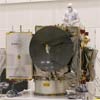
|
 |

Additional coverage for subscribers:
 VIDEO:
ANIMATED PREVIEW OF STEREO MISSION QT VIDEO:
ANIMATED PREVIEW OF STEREO MISSION QT
 VIDEO:
STEREO SPACECRAFT ASSEMBLED
QT VIDEO:
STEREO SPACECRAFT ASSEMBLED
QT
 SUBSCRIBE NOW SUBSCRIBE NOW

|
Antarctica is a hot spot for hunting meteorites
Not many people celebrate their year-end holidays on the east Antarctic ice sheet. But nearly every year for more than a decade, University of Arizona Lunar and Planetary Laboratory (LPL) professors, graduate students or alumni have.
 FULL STORY FULL STORY
 |  |
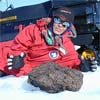
|
 |
OTHER HEADLINES Additional stories today
|
 |
Ames leads Robotic Lunar Exploration Program -- Monday, on the 36th anniversary of Apollo 12, NASA announced that it has assigned management of its Robotic Lunar Exploration Program to the Ames Research Center. Returning astronauts to the moon will start with robotic missions between 2008 and 2011 to study, map and learn about the lunar surface. These early missions will help determine lunar landing sites and whether resources, such as oxygen, hydrogen and metals, are available for use in NASA's long-term lunar exploration objectives.

Orbital receives contract for MEASAT-1R satellite -- Orbital Sciences Corporation announced Monday that MEASAT Satellite Systems of Kuala Lumpur, Malaysia, has signed a contract to purchase one geosynchronous communications satellite from the company.
|
 |
Star on the run
Using the European Southern Observatory's Very Large Telescope, astronomers have recorded a massive star moving at more than 2.6 million kilometres per hour. Its position in the sky leads to the suggestion that the star was kicked out from the Large Magellanic Cloud, providing indirect evidence for a massive black hole in the Milky Way's closest neighbor.
 FULL STORY FULL STORY
 |  |
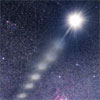
|
 |
Space probe rehearses landing dance with asteroid
With over a month of detailed remote study behind it, Japan's Hayabusa asteroid probe is ready to reach out and touch a small space rock hidden in the black depths of the solar system after a critical weekend test run confirmed all was ready for the high stakes operation that will gather the first ever asteroid samples destined for return to Earth.
 FULL STORY FULL STORY
 |  |
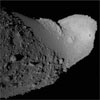
|
 |
Station crew rocks out during live concert
The International Space Station crew received a special live musical wakeup call from Paul McCartney during the first-ever concert linkup with a U.S. spacecraft. This morning's wakeup began Expedition 12's 44th day in space. NASA astronaut Bill McArthur and Russian cosmonaut Valery Tokarev listened to McCartney perform "Good Day Sunshine" and "English Tea" from the music icon's "US" Tour at Arrowhead Pond in Anaheim, Calif.
 LISTEN TO THE EVENT LISTEN TO THE EVENT
 |  |
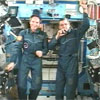
|
 |
Satellite trio at Saturn
This excellent grouping of three moons -- Dione, Tethys and Pandora -- near the rings provides a sampling of the diversity of worlds that exists in Saturn's realm as photographed by the orbiting Cassini spacecraft.
 FULL STORY FULL STORY
 |  |

|
 |
Europe's first Galileo satellites named 'GIOVE'
GIOVE - standing for 'Galileo In-Orbit Validation Element' - is the name that has been chosen for the two satellites which are currently being prepared to take the first step towards full deployment of Galileo, the European satellite navigation system. The first launch is scheduled for next month.
 FULL STORY FULL STORY
 |  |
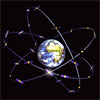
|
 |
Young stars sculpt gas with powerful outflows
This Hubble Space Telescope view shows one of the most dynamic and intricately detailed star-forming regions in space, located 210,000 light-years away in the Small Magellanic Cloud (SMC), a satellite galaxy of our Milky Way. At the centre of the region is a brilliant star cluster called NGC 346. A dramatic structure of arched, ragged filaments with a distinct ridge surrounds the cluster.
 FULL STORY FULL STORY
 |  |
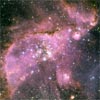
|
 |
OTHER HEADLINES Additional stories today
|
 |
Einstein's theory proven with the 'lead' of a pencil -- Scientists at The University of Manchester have discovered a new way to test Einstein's theory of relativity using the 'lead' of a pencil. Until now it was only possible to test the theory by building expensive machinery or by studying stars in distant galaxies, but a team of British, Russian and Dutch scientists has now proven it can be done in the lab using an ultra-thin material called Graphene.

Space station update -- With their first spacewalk behind them, the crew of the International Space Station pressed ahead this week to prepare for several upcoming milestones.

Cain heads shuttle launch integration at KSC -- Former flight director LeRoy Cain will direct all launch integration activities associated with the space shuttle at NASA's Kennedy Space Center, Fla., reporting directly to program manager Wayne Hale at the Johnson Space Center, Houston. He replaces astronaut Gregory C. Johnson, who returned to JSC after a year and a half.
|
 |
Spitzer captures cosmic mountains of creation
A new image from NASA's Spitzer Space Telescope reveals billowing mountains of dust ablaze with the fires of stellar youth. Captured by Spitzer's infrared eyes, the majestic image resembles the iconic "Pillars of Creation" picture taken of the Eagle Nebula in visible light by NASA's Hubble Space Telescope in 1995.
 FULL STORY FULL STORY
 |  |

|
 |
Wind chaos on Jupiter
Scientists from the Max-Planck Institute for Solar System Research, the University of Alberta in Edmonton, Canada, and the University of California Los Angeles, have now presented a new three-dimensional computer model that successfully describes and explains all important characteristics of the banded flows on Jupiter. The simulations suggest that the wind system may reach as deep as 7000 km into the planet's atmosphere.
 FULL STORY FULL STORY
 |  |

|
 |
OTHER HEADLINES Additional stories today
|
 |
UCSC physicists deliver detector for NASA's GLAST telescope -- After more than a decade of work, a team led by physicists at the University of California, Santa Cruz, has completed a major detector subsystem for NASA's Gamma-ray Large Area Space Telescope. GLAST will give astronomers a powerful new tool for studying the sources of high-energy gamma rays in the universe. It will help astronomers investigate poorly understood phenomena such as active galactic nuclei, quasars, pulsars, and gamma-ray bursts.

ILS signs contract to launch Thor II-R on Proton rocket -- International Launch Services, a Lockheed Martin company, and Orbital Sciences Corp. have signed a contract for launch of the Orbital-built Thor II-R satellite on a Proton Breeze M launch vehicle.
|
 |
Spacecraft sets sail to explore mysteries of Venus
Earth's twin planet has its first new permanent visitor in 15 years on the way after Wednesday's successful launch of Venus Express - a European probe that will orbit the second rock from the Sun to study its inhospitable and enigmatic atmosphere.
 FULL STORY FULL STORY
 MISSION STATUS CENTER MISSION STATUS CENTER
 |  |
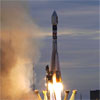
|
 |
Titan's ultraviolet haze
Looking back toward the Sun brings out the thin haze than hovers 310 miles above Saturn's moon Titan, as seen in this Cassini spacecraft image. Scientists are still trying to understand what processes produce this thin, high-altitude haze layer.
 FULL STORY FULL STORY
 |  |
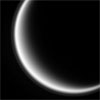
|
 |
Mobile communications satellite launched into orbit
The second step in a $1.5 billion program to create a mobile broadband communications network spanning the globe for users at sea, in the air and on land roared into space Tuesday.
 FULL STORY FULL STORY
 |  |
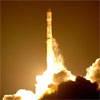
|
 |
OTHER HEADLINES Additional stories today
|
 |
NASA establishes Commercial Crew/Cargo Project Office -- NASA has formed the Commercial Crew/Cargo Project Office to spur private industry to provide cost-effective access to low-Earth orbit and the international space station in support of the Vision for Space Exploration.

Former astronaut named new Johnson Center director -- Mike Coats has been named director of NASA's Johnson Space Center. Coats is a former astronaut, and he currently is vice president of Lockheed Martin Astronautics in Denver.
|
 |
Spacewalkers complete
to-do list outside station
Spacewalker Bill McArthur, feet anchored at the top of the station's P6 solar array, threw a no-longer-needed 60-pound electrical instrument overboard Monday, tossing it into its own orbit from which it will eventually fall back into the atmosphere and burn up.
 FULL STORY FULL STORY
 MISSION STATUS CENTER MISSION STATUS CENTER
 |  |

|
 |

Additional coverage for subscribers:
 VIDEO:
SCIENCE PROBE TOSSED OVERBOARD BY SPACEWALKER PLAY VIDEO:
SCIENCE PROBE TOSSED OVERBOARD BY SPACEWALKER PLAY
 VIDEO:
VIDEO RECEIVED FROM THE STATION'S NEW CAMERA PLAY VIDEO:
VIDEO RECEIVED FROM THE STATION'S NEW CAMERA PLAY
 VIDEO:
SPACEWALKERS TRAVERSE OUTSIDE BETWEEN TASKS PLAY VIDEO:
SPACEWALKERS TRAVERSE OUTSIDE BETWEEN TASKS PLAY
 VIDEO:
CAMERA UMBILICALS HOOKED UP TO THE STATION PLAY VIDEO:
CAMERA UMBILICALS HOOKED UP TO THE STATION PLAY
 VIDEO:
INSTALLATION OF THE NEW TV CAMERA BEGINS PLAY VIDEO:
INSTALLATION OF THE NEW TV CAMERA BEGINS PLAY
 VIDEO:
THE CREW MAKE ITS WAY TO PORT 1 TRUSS PLAY VIDEO:
THE CREW MAKE ITS WAY TO PORT 1 TRUSS PLAY
 VIDEO:
SPACEWALKERS RETRIEVE TRIPOD FOR TV CAMERA PLAY VIDEO:
SPACEWALKERS RETRIEVE TRIPOD FOR TV CAMERA PLAY
 VIDEO:
VALVE POSITIONING ERROR DELAYS START OF EVA PLAY VIDEO:
VALVE POSITIONING ERROR DELAYS START OF EVA PLAY
 VIDEO:
SPACEWALK PREVIEW BRIEFING DIAL-UP | BROADBAND VIDEO:
SPACEWALK PREVIEW BRIEFING DIAL-UP | BROADBAND
 VIDEO:
NARRATED ANIMATION OF SPACEWALK TASKS PLAY VIDEO:
NARRATED ANIMATION OF SPACEWALK TASKS PLAY
 SUBSCRIBE NOW SUBSCRIBE NOW

|
Naming new lands on Titan
Like an ancient mariner charting the coastline of an unexplored wilderness, the Cassini spacecraft's repeated encounters with Saturn's moon Titan are turning a mysterious world into a more familiar place.
 FULL STORY FULL STORY
 |  |
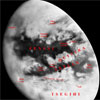
|
 |
Closest look yet at Milky Way's mysterious core
Astronomers have gotten their deepest glimpse into the heart of our Milky Way Galaxy, peering closer to the supermassive black hole at the Galaxy's core then ever before. They found that a radio-wave-emitting object at the Galaxy's center would nearly fit between the Earth and the Sun.
 FULL STORY FULL STORY
 |  |
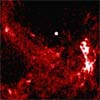
|
 |
Mars kicks up the dust as Hubble watches
NASA's Hubble Space Telescope snapped this picture of Mars on October 28, within a day of its closest approach to Earth on the night of October 29. Hubble astronomers were also excited to have captured a regional dust storm on Mars that has been growing and evolving over the past few weeks.
 FULL STORY FULL STORY
 |  |
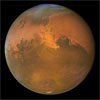
|
 |
Cosmic cloudshine
Hubble's iconic images include many shots of cosmic clouds of gas and dust called nebulae. For example, the famous "Pillars of Creation" mark the birthplace of new stars within the Eagle Nebula. Yet despite their beauty, visible-light images show only the nebulae surfaces. Baby stars may hide beneath, invisible even to Hubble's powerful gaze.
 FULL STORY FULL STORY
 |  |
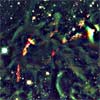
|
 |
OTHER HEADLINES Additional stories today
|
 |
Japanese entrepreneur to be next private astronaut -- Space Adventures has announced that Hong Kong resident and Japanese entrepreneur Daisuke Enomoto will be the next private space explorer candidate. The company which organized the spaceflights to the International Space Station for the world's first private explorers Dennis Tito, Mark Shuttleworth and Greg Olsen, disclosed that Enomoto's expedition is currently planned for October 2006.
|
 |
Damage prompts booster replacement for Pluto probe
Lockheed Martin technicians are replacing one of the solid-fuel boosters attached to the Atlas 5 rocket that will launch NASA's New Horizons spacecraft to Pluto because of damage the motor sustained during Hurricane Wilma.
 FULL STORY FULL STORY
 |  |

|
 |
Light seen from possibly first objects in universe
Scientists using NASA's Spitzer Space Telescope say they have detected light that may be from the earliest objects in the universe. If confirmed, the observation provides a glimpse of an era more than 13 billion years ago when, after the fading embers of the theorized Big Bang gave way to millions of years of pervasive darkness, the universe came alive.
 FULL STORY FULL STORY
 |  |

|
 |
Neutron star found where a black hole was expected
A very massive star collapsed to form a neutron star and not a black hole as anticipated, according to new results from NASA's Chandra X-ray Observatory. This discovery shows that nature has a harder time making black holes than previously thought.
 FULL STORY FULL STORY
 |  |
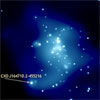
|
 |
OTHER HEADLINES Additional stories today
|
 |
NASA appoints Constellation Program managers -- Jeffrey Hanley has been appointed manager of NASA's Constellation Program. He will lead development of the nation's new spacecraft and launch system, which as part of the Vision for Space Exploration will take astronauts to the moon, Mars and beyond. Mark Geyer was appointed as deputy program manager.
|
 |
Launches delayed in the crossfire of Boeing strike
More than a thousand Boeing workers hit the picket lines Wednesday morning, snarling plans to launch a critical U.S. national security satellite and environmental research spacecraft aboard Delta rockets this year.
 FULL STORY FULL STORY
 |  |
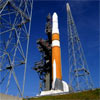
|
 |
Space telescope detects massive star partner
Scientists using NASA's Far Ultraviolet Spectroscopic Explorer satellite made the first direct detection of a companion star of Eta Carinae. Eta Carinae is one of the most massive and unusual stars in the Milky Way galaxy. The detection was made possible by the high temperature of the companion star and the unique sensitivity of the satellite at the shortest ultraviolet wavelengths.
 FULL STORY FULL STORY
 |  |

|
 |
ISS marks five years of a unique 'room with a view'
Break out the thermostabalized beef tips with mushrooms and rehydratable apple cider! NASA and the international space station partners are celebrating a major milestone, as the unique orbiting laboratory marks the fifth anniversary of continuous, onboard human presence. As of Wednesday, crews have lived and worked on the station more than 1,826 consecutive days.
 FULL STORY FULL STORY
 MORE: ANNIVERSARY VIDEO COVERAGE MORE: ANNIVERSARY VIDEO COVERAGE
 |  |

|
 |
|
Read our earlier news archive page.
|



